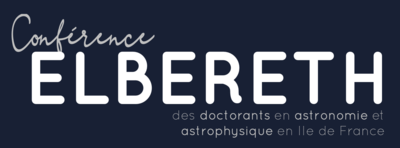Orateur
Description
Part of the ionizing continuum (Lyman continuum, LyC) produced by young stars can leak out of the host galaxy and ionize its surroundings. At high redshift, such LyC-leaking galaxies are among the best candidates to fully account for reionization (Robertson et al. 2013). However, direct measurements are extremely difficult as the LyC photons are easily absorbed by neutral gas on the observed line of sight. Instead, indirect tracers have been used to probe the structure of the interstellar medium (ISM) (e.g. Lyman alpha line, absorption lines) but such methods are also sensitive to line of sight selection effects. Using integrated emission lines in the optical and infrared domain mostly palliates viewing angle dependencies; it is a promising method to make the most of observations with current ground-based facilities (e.g., ALMA) and upcoming space missions (e.g., JWST) that will grant access to many spectroscopic tracers up to redshift above 7. However, a complex modeling step is much needed to take into account the available tracers originating in different phases and to consider a multi-component topology which matches the ISM signatures of known leaking galaxies (Ramambason et al. 2020).
Such complex representative models are crucial to investigate morphology-dependent questions such as the impact of the metal and dust content on the gas distribution and mass in the different reservoirs and the porosity to ionizing radiation. Local low-metallicity galaxies, with quasi-primordial-like physical conditions and with numerous emission lines available, are ideal laboratories to benchmark this new method and explore its predictive power in high-redshift galaxies for which only a few tracers are often observed. To constrain the parameters of this representative galaxy model, we co-developped MULTIGRIS (Lebouteiller & Ramambason in prep.) a new Bayesian code using MCMC sampling. Among the various applications, MULTIGRIS can produce probability density functions of physical parameters, either primary (density, ionization parameter, stellar population age etc...) or secondary (e.g., ionizing photon escape fraction, dust mass, H2 mass).
I will present the results obtained on the Dwarf Galaxy Survey (Madden et al. 2013), a sample of local, low-metallicity galaxies using combinations of Cloudy models (Ferland et al. 2017). We build upon previous results from Cormier et al. (2019) to quantify the larger porosity of the interstellar medium for low-metallicity galaxies, with the inferred topology having more density-bounded regions, leading to photons escaping the HII regions. We explore dependencies of ionizing photons escape fraction on our model parameters and discuss promising line ratios for future localand high-redshift studies.
Day constaints
no available on Thursday 24th
| Field | InterStellar Medium |
|---|

